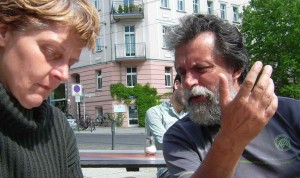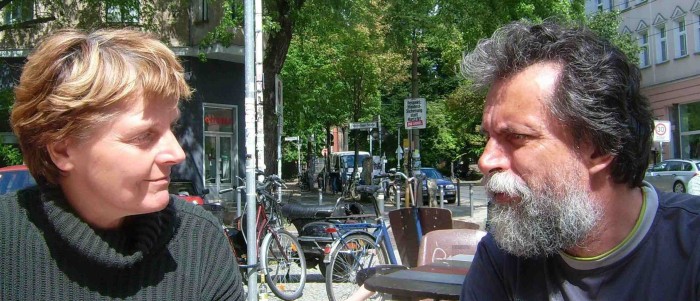Janez Bertoncelj
 |
Janez Bertoncelj is one of the very first persons who supported the idea of a Europe-wide campaign “30 km/h – make the streets liveable!” He is a member of the citizens´ committee for the ECI and the Slovenian national co-ordinator. His organisation is Slovenka kolesarska mreža, the Slovenian cyclists´ club.In the beginning of August 2013, Janez travelled to Berlin. Heike und Christina from the EU co-ordination office met him there, and though Janez was on his holidays, he answered our questions with patience. See an excerpt from our conversation. |
Question: Slovenia and urban mobility – could you tell us a few keywords?
Janez: In my country, personal cars are very popular. Slovenia has 2 million inhabitants, and 580 cars per 1000 inhabitants. This means that there is more than 1 car, nearly 2 cars in an average household. However, we don´t have any data about bicycles. This is very telling, isn´t it?
And the use of public buses has been declining in the last years.
Regarding road safety, we are in the middle of the European records. Our normal urban speed limit is 50 km/h as it is in nearly all other countries. But I am not happy about the situation on our roads.

Why did you join the network for 30 km/h?
Janez: It was actually an invitation by ECF. They had asked for suggestions about important issues and I had answered: 30 km/h would be good for ECF activities. Back came an email from Martti Tulenheimo (who is now a member of the citizens´ committee for the ECI): “There is already something happening, plans about an ECI. Don´t you want to join this network?” – And I did want.
The second reason was that I knew already about the “20sPlentyforUs” website and their campaign in the UK which I found absolutely inspiring. Then I was informed that “20sPlentyforUs” was already a partner in the network. The decision to take part in the campaign was then easily taken.
When a bad accident happened in May, it confirmed my feelings that this campaign is really important. Two girls aged 19 were killed by a drunken and speeding car-driver. After this happened, our cycling organisation, the girls´ family and the whole neighbourhood wrote an article and complained to the municipality. Our suggestion was that the design of the city streets should always be safe and friendly for vulnerable users and better protecting even in extreme cases. The existing streets were however inviting to speed. Experts had predicted that something might happen one day as the traffic was too fast. And there is even a primary school just 200 meters away from the point where the accident happened.
The authority reacted and promised traffic lights but we wanted more. We wanted chicanes and I am sure that you must change the design and the law, it is not done by signals. But the authority responded saying that this accident was exceptional and nothing had happened until that time, that it was unpredictable and only due to an extreme situation and person. By the way: the driver escaped, but came back to the point of the accident and was caught
The only thing we could achieve was the beginning of intense discussions. But the people just forget it again as time passes by. We need to do more.
 |
What would you say are the most important benefits of a legislation with 30 km/h as regular speed limit?
Janez: You don´t need to separate cycles from cars. If you have mixed traffic in the city, the cyclists are slowing down the cars and all are travelling constantly and fluently.
I believe that it is much better to achieve safety by behaviour than by building expensive infrastructure. I therefore support the idea of sharing the space thoughtfully.
Are you disappointed about the low number of signatures gathered so far?
Janez: To be honest, I didn´t expect that we could reach the one million signatures from the very beginning. And the number is not too bad. Imagine, Slovenia is a small country, with people living scattered here and there. They are dependent on their cars, and we have a high amount of commuters. Therefore, we could not expect a high number of people signing but it is a great opportunity to put the issue on the agenda and discuss it.
People have been walking for millions of years. Our minds simply can´t be adopted to high speeds.
The old city streets were never built for cars but for people. People could walk in the middle of the streets. That was just normal. Cars came later but they took our space.
Life was in the streets not in the buildings. Cars are taking .our space.
But the streets are not paid by car drivers only. They are paid by all tax payers.
What is an important criteria for a liveable city is that children can play on the streets.
Being able to move around is important for their healthy development. They usually achieve better results at school even if their parents don´t care so much. This is because they have social contacts on the street and can achieve social competence.




